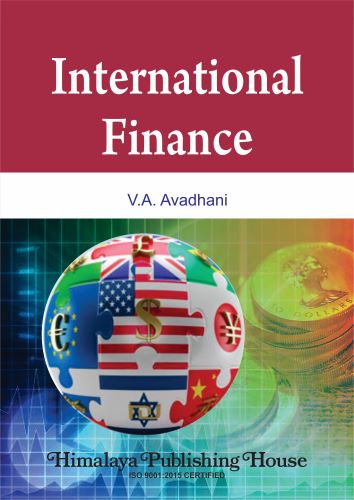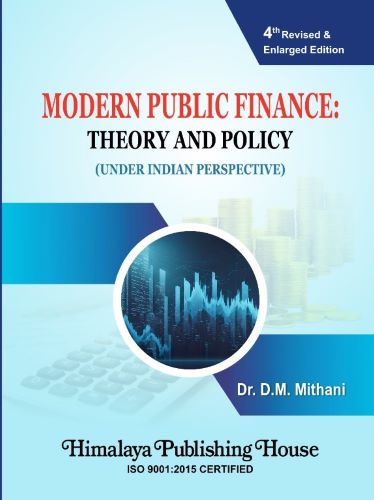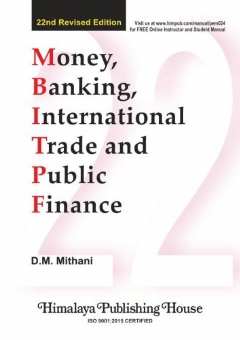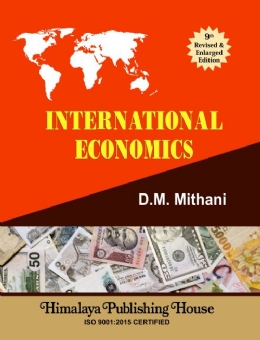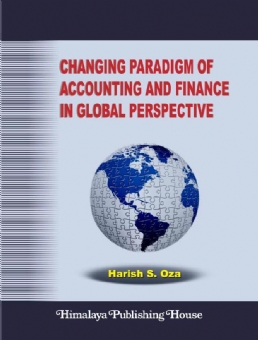The present revision of this book has to be viewed in the background of the basics on which it was built. Any book on International Finance has to deal with all the components of the International Financial System. So this book started with the present International Financial System vis-à-vis the domestic system — financial system as against the real system and the International Monetary Fund, and New International Economic order, etc. The new order should bring out the role of emerging market economies like China and India and their new role among the developing countries. These relations among countries are undergoing changes which have to be brought out in this revision. The emerging market economies and among them the Asian developing countries have been called upon to play a more dynamic role in the world economic order. The components and institutions in the International Financial System (IFS) are changing and their role and operations particularly, in relation to India are bound to change with the changing socio-political and economic conditions in the real world. These are incorporated in this revision.
The present revision has incorporated all the latest changes in policies and practices and tried to present a correct picture of the contents as much as possible within the constraints of space and context. The current policies of trade and commercial policy and our compliance with the WTO requirements are all brought out.
Contents :
Part – I : International Financial System
1. INTRODUCTION TO INTERNATIONAL FINANCE
Scope of the Book – Relevance to Management – Finance Function – Input Market – Output Market – Sources and Uses – Macro View of Foreign Flows – Sectoral Interdependence – Intra-National Dependence.
2. INTERNATIONAL TRADE AND INTERNATIONAL FINANCE
Trade and Balance of Payments – Current Items – Capital Items – Components of International Financial System – Foreign Exchange Market – International Currency Markets – Institutions in International Financial System.
3. THE INTERNATIONAL MONETARY SYSTEM
Objectives of IMF – Fund’s Role of Consultation – Sources of Funds — Quotas – Share Capital of IMF – Other Sources of Funds – Fund’s Lending Operations – Standly Arrangements – IMF Charges – Other Facilities – Exchange Rates and Par Values – International Monetary Reforms – International Liquidity – Need for Reserves– Composition and Level – Adequacy of Reserves – Problems of Liquidity – Augmentation of Liquidity – Special Drawing Rights (SDRs) – SDR Allocation – Limitations – Uses – SDRs in India – India’s IMF Net Position – Additional SDRs.
4. NEW INTERNATIONAL ECONOMIC ORDER
World Trade Trends – World Aid Trends – Role of MNCs – World Monetary Trends – Role of GATT – Role of UNCTAD – Origin in NIEO – Emergence of North-South Dialogue – Objectives – Elements – Implementation of N.I.E.O. Action Programme – Growth of Regionalism.
5. GLOBALISATION FORCES
Definition – Hurdles to Globalisation – Management of Change to Globalisation – Strategic Planning – Recent Environmental Changes – Macro Environment – Requisites for Globalisation – Inevitable Forces of Globalisation – Globalisation Models – Environmental Adaption for Globalisation – Financial Environment – World Economic Trends – Policy Changes – Monetary and Credit Trends – Trade Policy and Trends – Liberalised Access to Foreign Borrowing – Capital and Stock Markets – Conclusion.
Part – II : International Trade — Theory and Practice
6. TRADE THEORY
Domestic and Foreign Trade – Barter Trade vs. Money Trade – Classical Trade Theories — Absolute Advantage – Comparative Advantage – Labour Theory of Value — Supply of Goods – Heckscher-Ohlin Theorem – Theory of Commodity and Factor Price Equalisation – Leontief Paradox – Reciprocal Demand (J.S. Mill) – Indifference Curves – Offer Curves – Changes in Demand – Trade Gains – Generalised Trade Theory.
7. HABERLER’S OPPORTUNITY COST THEORY
Introduction – What is Opportunity Cost? – Representation of Opportunity Costs – Position Under Constant Returns (Costs) – Position Under Increasing Costs – Case of Decreasing Costs – International Trade Possibilities – Trade Under Conditions of Constant Costs – Actual Trade Possibility – Trade Possibility under Constant Costs – Case of Increasing Costs – Evaluation – Criticism.
8. HECKSCHER – OHLIN THEOREM
Introduction – Is there any Need for a Separate Theory? – Basis of Ohlin’s Theory – Elements of Ohlin’s Theory – Assumptions – Factor Abundance — Main Factor Explained – Abundance of Capital in the USA – Labour Abundance in India – Price Criterion – Factor Proportion Theory – Physical Criteria – Assumptions of the Theory Given Up – The modern Theory of International Trade – (Equilibrium Analysis) – Introduction – General Equilibrium Approach – P-P Curve – Definition of Indifference Curves – Application of Indifference Curves – Production – Consumption – General Equilibrium – Basic Postulates of Ohlin Theory – Factor-Price Equalisation Theorem – Limitations – Diagrammatic Representation of Factor-Price Equalisation Theorem – Leontief Paradox — Failure of Ohlin’s Theory – Paradox Explained – Contribution of Heckscher and Ohlin – Critical Evaluation of Heckscher-Ohlin Model – Modern Theory vs. Classical Theory.
9. RECENT THEORIES OF INTERNATIONAL TRADE
Kravis Theory – Kindleberger’s Thesis – Bhagwati’s Hypothesis – The Metzler Paradox – “Dutch Disease” – Falvey-Kierzkowski Model – Lerner Symmetry Theorem – Eckaus Theory – Stolper-Samuelson Theorem – Kuhn’s Theorem – Rybczynski Theorem – Technology and Trade Theory – Emerging Models.
10. GAINS FROM TRADE
Introduction – A. Gains to the Exporting Country – B. Gains to the Importing Country – C. Overall Gains to the World – Factors Influencing Gains – Measurement of Gains – Gains Represented Diagrammatically.
11. TERMS OF TRADE
Definition – Favourable and Unfavourable Terms – Demand Side of Trade – J. S. Mill’s Thesis – Reciprocal Demand – Exchange Ratios – Assumptions – Offer Curves (Marshall-Edgeworth Analysis) – Assumptions in Marshall — Edgeworth Analysis – Critical Appraisal – Factors influencing Terms of Trade – Effect of Transport Costs – Elasticities – Price Elasticity – Income Elasticity – Factors Influencing Elasticities – Elasticity Pessimism – Measurement – Concepts of Terms of Trade – Terms of Trade and Welfare – Factoral Terms – Income Terms of Trade – Real Cost Terms of Trade – Utility Terms of Trade – Usefulness of the Concepts – Terms of Trade in India – Causes for Deterioration in Terms of Trade.
12. DYNAMICS OF INTERNATIONAL TRADE
Effect of Tastes – Changes in Factor Endowments – Technology Changes – Trade and Growth in the LDCs – Linkages — Forward and Backward – National Income and Trade (Exports) – Imports and Growth – Terms of Trade – Elasticities.
13. INDIA’S FOREIGN TRADE
Introduction – Importance of Foreign Trade – Trade Philosophy – Organisational Framework for Trade – Trends on Trade – Invisible Trade – Direction of Trade – Terms of Trade – Composition of Trade – Structural Changes – Government Share in Foreign Trade – Trade Policy – Foreign Sector – Trade as an Engine of Growth – Project and Consultancy Exports – Exim Policy – Exim Policy of 1999-2000 – Exim Policy 2000-01 – Exim Policy 2002-07 (Tenth Plan) – Tenth Plan Agenda for Exports – Indian Shipping and Other Infrastructure – Problems of Indian Shipping – Banking and Foreign Sector – Marine Insurance – Latest Exim Policy Trends – Foreign Trade Policy 2004-09 – Recent Foreign Trade Policy Change – Appendix I and II.
Part – III : Balance of Payments and Restrictive Policies
14. BALANCE OF PAYMENTS THEORY
Definition – Accounting of Balance of Payments – Sources of Compilation – Limitations in Compilation – Components of Balance of Payments – Balance of Payments Data – Mechanism of Adjustment – Price Mechanism – Income Adjustment – Absorption Approach of Alexander – Elasticity Approach vs. Absorption Approach – General Equilibrium Approaches – Balance of Payments — Measurement of Deficits.
15. INDIA’S BALANCE OF PAYMENTS
Introduction – Sectoral Breakdowns – Sources of Data in India – Trends in Balance of Payments – Role of Services in Balance of Payments – Non-resident Inflows – Services Sector in India’s Trade – Foreign Exchange Reserves – Foreign Assistance – Appendix I.
16. BILATERALISM IN FOREIGN TRADE
Why Bilateralism? – Role of Bilateralism in India – Types of Agreements – Direction of Trade – FTAs and Direction of Trade – Composition of Bilateral Trade – Gains from Bilateral Trade – Mechanics of Payments – Counter Trade – State Trading Corporation – Criticism of STC – MMTC.
17. COMMERCIAL POLICY AND THEORY OF TARIFFS
Definition – Free Trade vs. Protection – Effects of Tariffs – Effective Rate of Protection – Concepts of Protection – Non-economic Arguments for Protection – Economic Arguments for Protection.
18. INTERNATIONAL TRADE ORGANISATIONS
GATT – UNCTAD – World Trade Organisation (WTO) – Objectives of GATT – GATT and MFN Clause – Tariff Negotiations – Final Act of GATT, (1994) – WTO vs. GATT – Functions of United Nations Conference on Trade and Development (UNCTAD) – UNCTAD Conferences – UNCTAD – X at Bangkok – WTO Origin and Functions – Main Issues in WTO – WTO – TRIPS — Uruguay Round – Trade Related Investment Measures (TRIMs) – Indian Intellectual Property (TRIPS) – WTO – Disputes Settlement Body – WTO – Trade Policy Review Body (TPRB) – Trade Policy under WTO – Recent WTO Operations – WTO Seattle Conference – Uruguay Round — AOA – Doha Ministerial Conference – WTO Consultations – India’s Post Cancum Consultations – Patents and Trade Marks – Indian Patents Law – Trade Marks – Trade and Merchandise Marks Act – Procedures – Patents (Amendment) Act, 1999 – Patent Norms Revised 2006 – WTO and Policy Changes.
19. COMMERCIAL POLICY IN INDIA
Tools of Commercial Policy – Control on Trade – Trends in Export Duties – Trends in Imports Duties – Subsidies and Incentives – (a) Fiscal Incentives – Customs and Excise Duty Drawback Scheme (b) Financial Incentives – (c) Special Incentive Schemes – Advance Licensing System – (d) Other Incentives – Aid to Export by SSIs – Import-Export Policy Export Processing Zones (F.T. Zones) – 100% Export-Oriented Units (EOU) – Special Economic Zones (SEZ) – Trade Development Authority (TDA) – Other Institutional Agencies.
20. THEORY OF CUSTOMS UNION AND REGIONAL ECONOMIC CO-OPERATION
What is Customs Union? – Trade Creation and Trade Diversion – Gains – Dynamic Effects – Economic Co-operation among Developing Countries – Regional Co-operation – Asian Clearing Union – Purposes – Constitution – Unit of Account – Eligible Transactions – Eligible Instruments – Settlement of Accounts – Benefits of ACU – AMU Rates – South Asian Association for Regional Co-operation (SAARC) – Benefits of Regional Groupings – Regional Co-operation and India – Regional Trade Agreements.
21. EXCHANGE MANAGEMENT IN INDIA
Introduction – RBI as the Exchange Control Authority – Authorised Dealers (A.Ds.) – Money Changers – Permitted Method – Other Receipts – Payment for Imports – Other Payments – Delegation to ADs – Forward Covers – Securities – Foreign Currency Accounts – Non-resident Accounts – Non-resident (Banks) Accounts – Loans and Overdrafts – Blocked Accounts – Liberalisation of Exchange Control – Capital Account Liberalisation – Recent Liberalisation Measures – Sodhani Committee Recommendations – Exchange Rate Management – RBI on Exchange Control Norms – The FEMA 2000 – Road Map to Capital Account Liberalisation – Recent Foreign Exchange Policy Changes.
Part – IV: International Marketing and Trade Practices and Procedures
22. INTERNATIONAL MARKETING
Marketing Concepts – Foreign vs. Domestic Markets – Market Information – Evaluation of Market Research – Export Marketing Policy – Macro-level Marketing Strategy – Search for Markets – Micro-level Marketing Strategy – Product-mix and Brand Patenting – Pricing – Promotion Measures – Evaluation and Control – Risk in Export Markets
23. GOVERNMENT REGULATIONS AND PROCEDURES
Licensing Policy – Licensing Authority – Sponsoring Authority – Procedures – Import Licences Export Licences – Alexander Committee – Abid Hussain Committee – Import-Export Policy (Exim Policy) – Thrust on Export Promotion and Import Substitution – Exim Policy (Contiinued) – Export Credit Guarantee Corporation (ECGC) and Exporters – ECGC’s Role – Standard Policies Terms and Coverage, etc., Subject to Change – Types of Policies – Settlement of Claims – Procedure for Insurance – Specific Policies – The Berne Union – Financial Guarantees – Packing Credit Guarantee – Post-shipment Export Credit Guarantee – Export Finance Guarantee – Export Production Finance Guarantee – Export Performance Guarantee.
24. EXPORT-IMPORT PROCEDURES AND DOCUMENTATION
Foreign Enquiries – Sale Terms – Role of Freight and Insurance – Payment Terms – Buyers’ Credit – Lines of Credit – Letters of Credit — Documentary and Nondocumentary – Net to Replace NC – Types of Credit – Main Documents of Foreign Trade – Legal Requirements – Other Foreign Trade Procedures – Appendix.
25. OPERATIONS OF BANKS, IDBI AND EXIM BANK
Organisation – Import Credits – Export Credit – Parties Involved In Foreign Trade – Mode of Bank Finance to Exporters – Method of Payments – Bank’s Exchange Transactions – Sale and Purchase – Spot and Forward – Nostro, Vostro and Loro Accounts – Principle of “Valuer Compensee” – Rate of Interest – Buying and Selling Rates@ – Types of Rates – Long Rates – Tel Quel Rates – Forward Rates – Inter Bank Trading – Exchange Rates and Forward Premia – Option Deals – Swap Transactions – Export Finance and Banks – Importance of Export Finance – Quantum of Export Finance – RBI Export Credit – Export Credit (Interest Subsidy) Schemes – Duty Drawback Scheme – Export Credit Terms – IDBI — Export Finance – Export Market for Small Scale Industries – Exim Bank – Objectives – Organisation – Functions of Exim Bank – Incidental Functions – Operations – Programmes.
26. BANKS AND EXTERNAL SECTOR
Problems of Balance of Payments – Industrial and Trade Policy Changes – Plan Achievements – Export Credit – Export Credit Refinance – Export and Import Bank of India – Export Assistance – Banks and Indian Companies – Banks And Foreign Capital – Exchange Rate and Banks – Recent Changes in Bank Activity – Invisible Trade and Banks – Factoring – What is Forfeiting? – Factoring Vs. Forfeiting – Problem Areas in Forfeiting – Factoring and Forfeiting – Other Services – Impact of Forfeiting – Factoring and Balance Sheet – Effects.
Part – V : Foreign Markets
27. FOREIGN EXCHANGE MARKET
Definition – International Financial System and Foreign Exchange Market – Foreign Sector and Foreign Exchange Market – Banks’ Purchase and Sale – Instruments of Credit Traded – Foreign Exchange Market Components – Exchange Rate Mechanism – Gustav’s Theory – Limitations – Spot and Forward Rates – Speculation – Arbitrage – Indian Foreign Exchange Market – Exchange Dealers – RBI and Exchange Market – Exchange Rate System in India – Floating vs. Fixed Exchange Rates – Advantage of Basket Currencies – Present Exchange Rate System – RBI Policy Applied to Banks – Currency Deals – Method of Quotation – Trading by Banks – SPOT Trading Operations – Exchange Rates in India – Cross Currency Deals – Mismatch – Need For Matching – Forex Management – Explanation of Cross Rates – Derivative Products – Forward Contracts – Swaps – Market for Rupee – Options – Futures and Options – Forward Rate Agreements (FRA) – Forward and Future Contracts – Currency and Interest Rate Swaps – Sodhani Committee Report (1995) – Capital Account Convertibility Measures.
28. EURO-CURRENCY MARKETS
International Money and Capital Markets – Exchange Markets vs. Currency Markets – Origins of the Euro-Currency Markets – Dealers in the Market – Euro-Bond Markets – Magnitude of Trade – Market Features – Regulations – Bearer Status – Instruments Issued and Traded – Lawyers and Auditors – Euro Bond Clearing and Settlement System – Asian Currency Market – Petro-Dollar Market – Impact on Exchange Markets – Segments of the Market – Sources and Uses – Size and Growth of the Market in Euro-dollars – Techniques of Operations – Importance of the Market – India and Foreign Currency Markets – International Financial Centre in India.
29. FOREIGN AID AND TERM-LENDING (BOND MARKETS)
Introduction – Theory of Foreign Capital Flow – Aid Requirements – Criteria Governing Aid – Trends in Aid to India – Types of Aid – Forms of Aid – Desirable Pattern of Flows – Indirect Aid – Advantages and Disadvantages of Aid – Debt Burden of Government – Foreign Investment in India – Latest Foreign Investment Policy – NRI Schemes – New Foreign Currency (Non-resident) Accounts (Banks) Scheme – Government Guidelines On Private Foreign Investment (Rules Regarding NRI Investment) – Direct Investment with Out Repatriation Benefits – Other Investments – RBI Liberalisation of NRI Investments – Borrowing Abroad — Government Guidelines on Domestic Companies’ – Policy on Euro-Currency Borrowing – Latest ECB Trends – Indian Aid to Other Countries – Magnitude of External Assistance – Joint Ventures – Government Policy Guidelines – India’s Direct Investment Abroad – Multinational Corporations (MNCs) – Definition – Rationale of the Dominance of MNCs – Merits and Demerits – Re-assessment of the MNCs’ Role – International Long-term Lending — World Bank – The International Development Association (IDA) – International Finance Corporation (IFC) – The Bank for International Settlements (BIS) – Asian Development Bank (ADB).
30. FOREIGN EXCHANGE ARITHMETIC
Introduction – Factors Influencing Bank Margin – Forward Rate – Role of Interest Rates – Maturity Period – How to Calculate Forward Rate – Exchange Arithmetic – Problem on Interest Rates – Cross Rates for Non-dolar Currencies – Example of a Swap – Interest Factor in Exchange Arithmetic – Forward Rates – Quotes and Dealings of Indian Banks – Take an Example – A Real Case of Exchange Quotations.
Part – VI : Foreign Exchange Risks Management
31. FOREIGN EXCHANGE RISKS MANAGEMENT
Introduction – Strength of Currency – Exchange Risk Defined – Factors Affecting Exchange Rates – Types of Risk – Exchange Rate Management in India – Full Convertibility of Rupee – Multilateral Investment Guarantee Agency – FERA Liberalisation – Trade and Exchange Risk – Exchange Rate and Currency Risk – Types of Exchange Rates – Arbitrage and Speculation – Types of Risk in Foreign Exchange – Coverage of Risks – Market Makers in Foreign Exchange Market – Risk in Forward Market – Portfolio Management in Foreign Assets.
32. DERIVATIVES FUTURES AND OPTIONS
Why Derivative Markets? – Pitfalls – Role of Regulator – Trading in Derivatives – Problems – Currency Futures and Options – Futures and Forwards – Currency Options – Differences Between Futures and Options – Market Structure – Futures Options – Risk Management in India – Managing Financial Risk in India – Methods of Meeting these Risks – Repos – Short Positions – Asset Based Securitisation – Strips – Credit Risk Management – Interest Rate Risk – Interest Rate Swaps (IRS) – Derivatives Trading in India.
33. SWAP SWITCHES
Motivation for Swaps – Economic Advantages of Swaps – Currency Swaps – Debt-Equity Swaps – Nature of Swaps – Swap of Funds – Types of Swaps – Interest Rate Swaps – Fixed Rate Currency Swaps – Cross Currency Interest Rate Swap – Multilegged Swap – Basis Swaps – Interest Rate Swaps in India – Interest Rate and Currency Swaps – Advantages – RBI Scheme of Interest Rate Swaps.
34. OUTSOURCING AND BPO
Theory of Outsourcing – Outsourcing as Extension of Foreign Trade – Strength of BPO – Advantages of BPO – Disadvantages – ITES-BPO – Six Sigma Methodology – New Trends in Outsourcing – Outsourcing by Banks – Data Importance in BPO – Present BPO Companies in India.
35. SELECT BIBLIOGRAPHY

